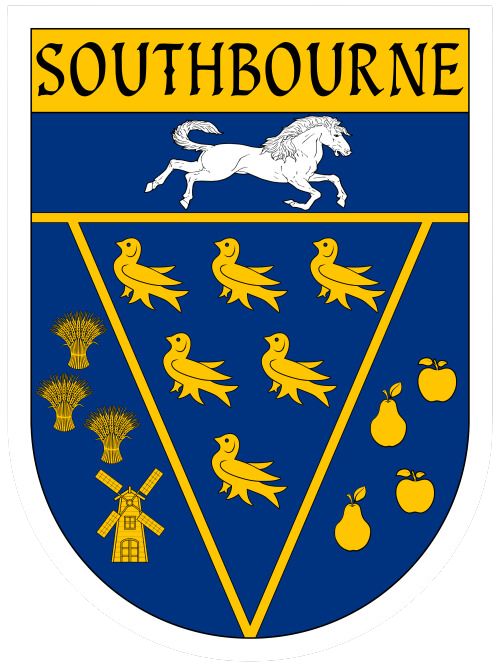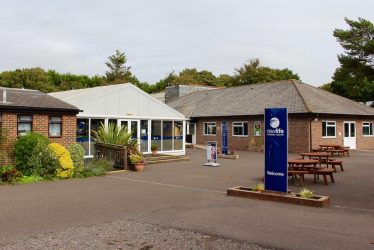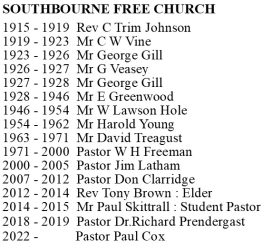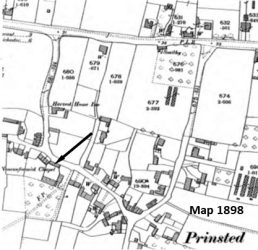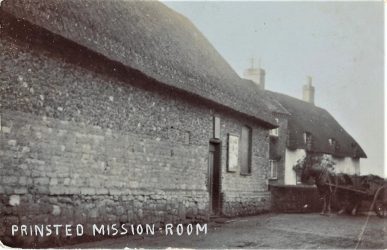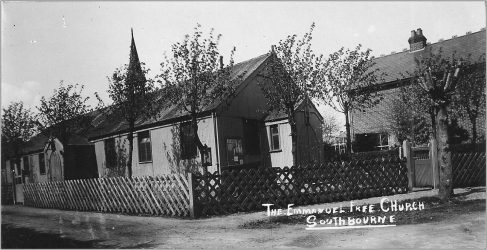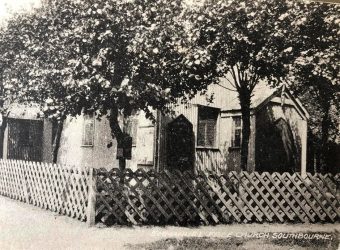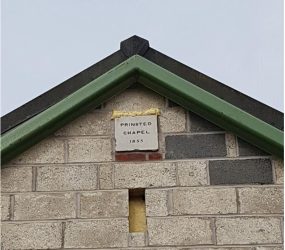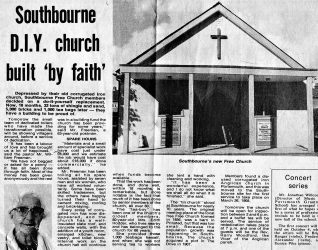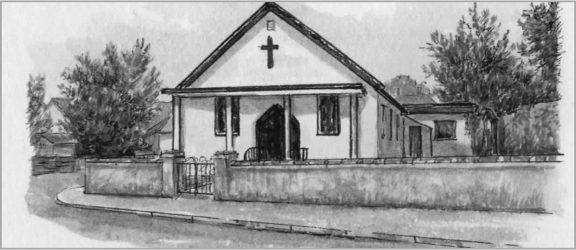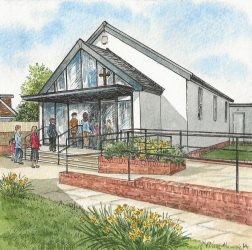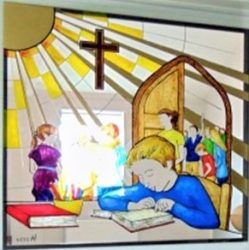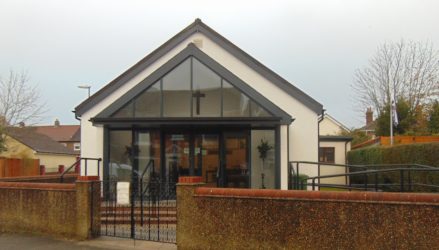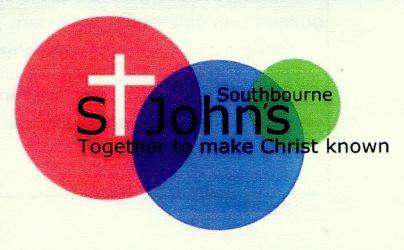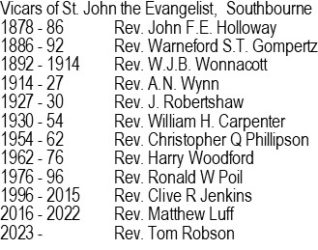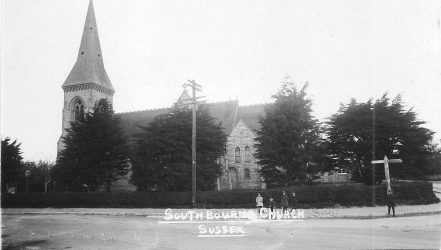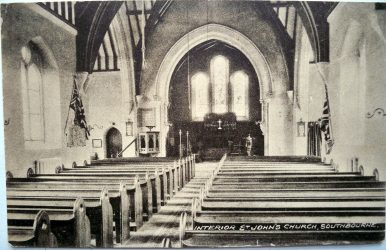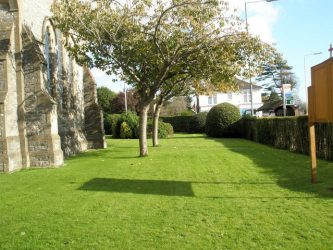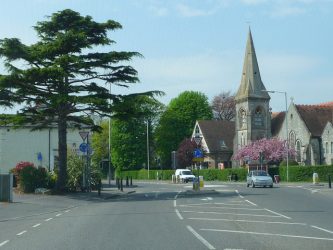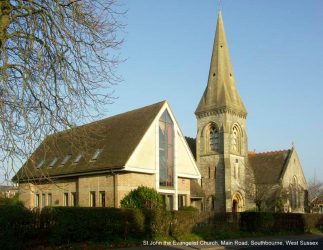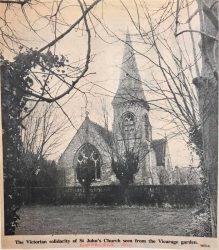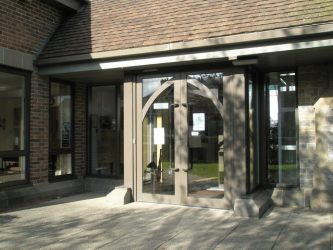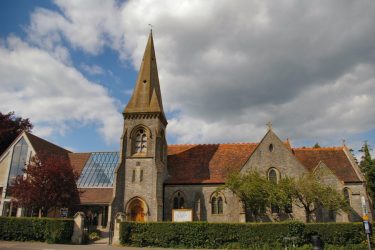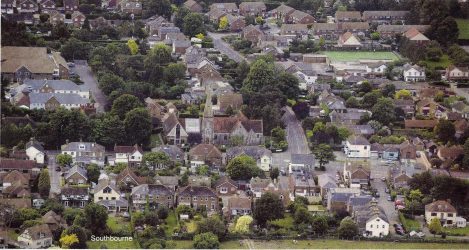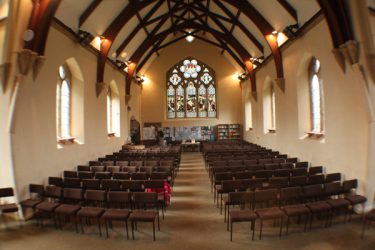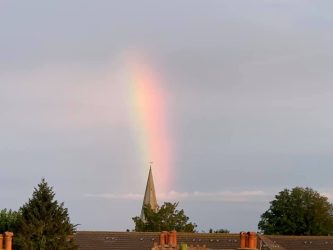History of St John the Evangelist
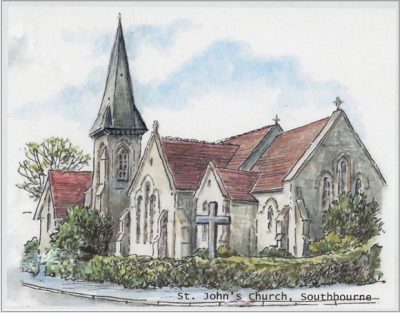
Church History by Mr Harris 1967
There are two individual recollections of the history of the church, one by Mr. Harris and the second by Pat Poil. Ronald Poil was vicar from 1976 to 1996 and during this time the new vicarage and the Church Centre were built.
Looking Back by H W Harris 1967
In attempting to put together a History of the parish of Southbourne one must inevitably start with Westbourne because, until 1878, Southbourne was an integral part of Westbourne.
The Manors
In Anglo-Saxon times Bourne (the old name for Westbourne) belonged to Earl Godwin, father of Harold the last Saxon King of England, and he had a great house at Bosham. After the Norman Conquest, Bourne was part of the great estates given by the Conqueror to his relative, Roger de Montgomery, First Earl of Arundel. In the Domesday Book, compiled in 1086, the manor of Bourne is mentioned and it probably included most, if not all, the present parishes of Westbourne, Southbourne, Warblington with Emsworth and Stansted. It was part of the Honour of Arundel (an “honour“ was a collection of manors in the hands of the same lord). Warblington was soon separated and by 1290 new independent manors had been formed at Nutbourne and Aldsworth.
The manors of Prinsted, Stansted and Woodmancote seem to have acquired an intermediate status as 2 members of the Bourne Manor” with definite boundaries but no manor court. Stansted and Woodmancote became separate independent manors in the 15th century but Prinsted did not achieve independence until the latter part of the 16th century, when the manorial system was dying. Westbourne, Stansted and Prinsted were usually held by the same Lord: from 1086 to 1580 by the Earls of Arundel and from 1580 to 1781 by the family of Lumley.
Godwin of Wessex Godwine; c. 1001 – 15 April 1053) was an English nobleman who became one of the most powerful earls in England under the Danish king Cnut the Great (King of England from 1016 to 1035) and his successors. Cnut made Godwin the first Earl of Wessex (c. 1020). Godwin was the father of King Harold ll (r. January –October 1066) and of Edith of Wessex, who in 1045 married King Edward the Confessor (r. 1042–1066).
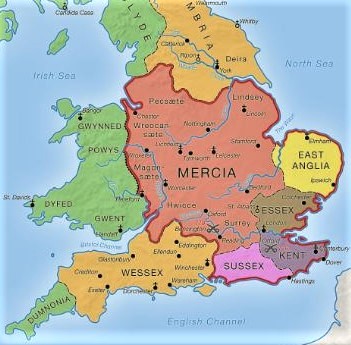
Manor of Prinsted
There is a very interesting map of this manor still extant, bearing the inscription:
“A plot of the Manor of Prinsted in the Parish of Westbourne in the County of Sussex, belonging to the Right Honourable Sir Richard Lumley, Knight, Lord Viscount Lumley. Taken in the year of our Lord God 1640 by Thomas Kington”.
In area it stretched from the Hampshire County Boundary to roughly where the Travellers’ Joy now stands and from the shore to a line approximately parallel to the railway some 300 yards to the north of it; it included all of Breach and Priors Leaze and a part of Hambrook. On the north it adjoined the manors of Westbourne and Woodmancote and to the east, Nutbourne. The only roads shown are the main road, the two Prinsted lanes, Stein Road, Inlands Lane, Priors Leaze Lane and what is now called Cooks Lane, and they are all in the present positions. No road is shown to Thorney, it presumably went round the shore from Slipper. Cot Lane, Chidham just gets into the edge of the map but it is called Coate Lane.
Now let us walk down the main road starting from the bridge which on the map is called Prinsted Bridge (now Hermitage Bridge) and spans a stream running through Norton Common most of which is now covered by the Mill Pond. On the left, there are several small enclosed plots or “crofts” starting with Chapel Croft on which it is probable that the Hermit’s Chapel of St. Anthony stood, of which more later. Only seven houses are shown in the Hermitage area and these crofts stretched as far as where “Wayside” now stands. Then follows a large field, a common field, called Nogland Field with another one called Markhams going back behind the crofts. Next, we come to the Garson, covering an area perhaps a little larger than the present Garsons Road. “Garson” is derived from the Saxon gaerstun” which means an enclosure of grass or a meadow and appears in other parts of Sussex as “Gasson”. From this point to the present Church Corner and stretching up Stein Road beyond the Manor is a large common field call “Langelands”, a name which has been perpetuated in Longlands Terrace. The next field covering the area from Stein Road to the Travellers Joy and back as far as the railway is called “The Steane”.
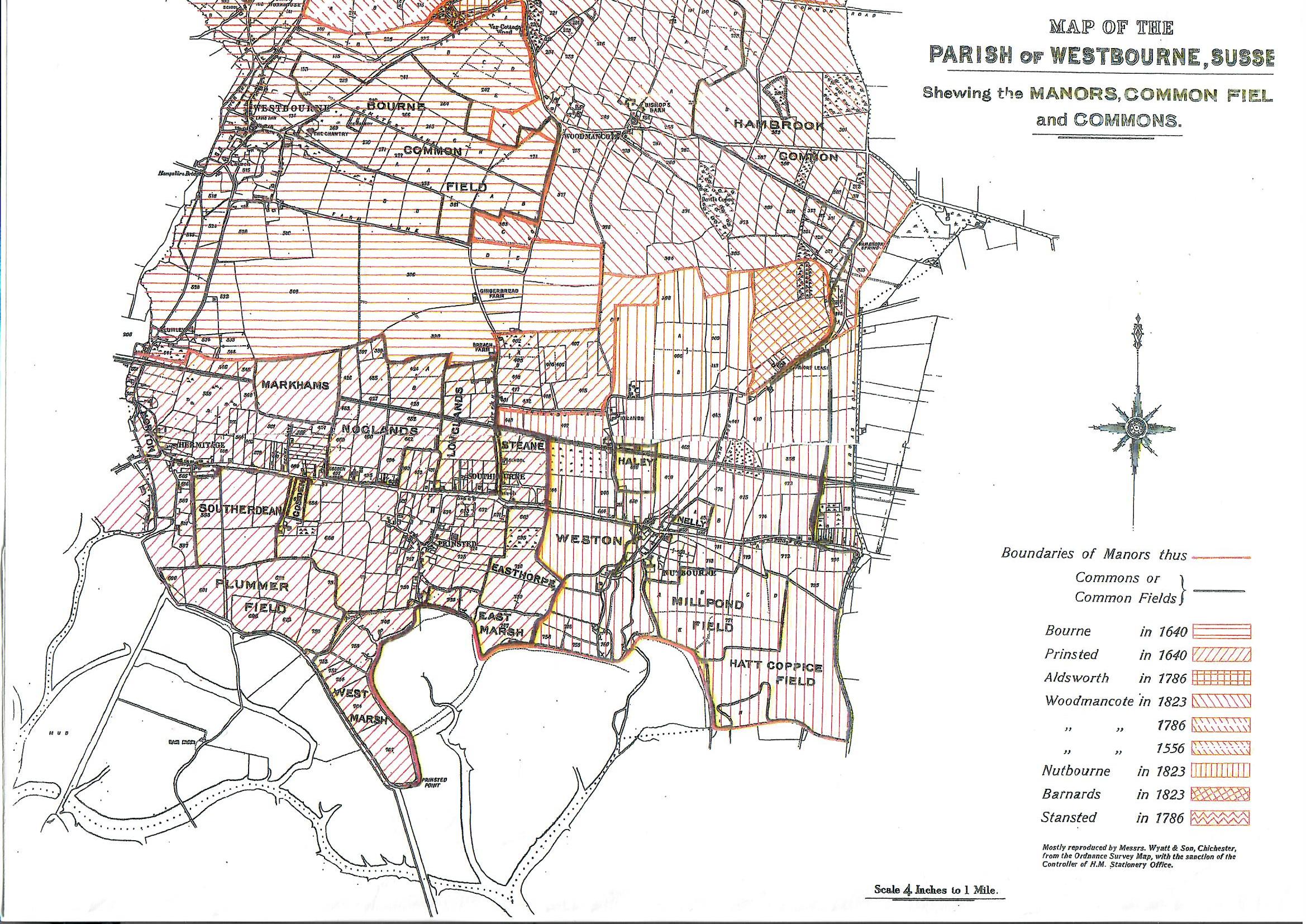
Westbourne Parish Map.
This map will help locate the fields mentioned in Mr. Harris's book. The whole area shown was in the Parish of Westbourne until St. John's Church was completed in 1876 and the new Chapelry of Southbourne created. The Parochial Parish Council administered the area until the creation of the Civil Parish Council in 1967.
Now let us look at the right-hand side of the Main Road again starting from the bridge. Opposite the Crofts is a large common field called “Southerdean” followed by six acres of “Goosedowne Green” where Gosden Cottage now stands. Then follows several fields and crofts held by the copyholders and freeholders living in the hamlet of Prinsted. This hamlet occupied exactly the same position as today and some of the houses marked on the map are still there today, e.g. “The Old House” and the cottages in the Square. Opposite the Steane Field in the Main Road is yet another common field called “Eastope” which extended as far as the East Marsh. Thornham is shown just where it is today as part of Plumer Field. In the area bounded today by Stein Road, Breach Avenue, Loveders Farm and Cooks Lane, were “The Breach Crofts”, twenty-two small fields averaging two acres apiece. 168 acres of Hambrook also belonged to the Manor of Prinsted but we are not concerned with that here.
On the east side of the junction of Cot Lane and the Main Road, the map shows “Pardon Bush”. Apparently, when the bounds of the parish were beaten farthings were thrown into this bush for the boys to scramble for. The scratches they got in the process were supposed to impress on their memories the place where the boundary was.
Hermitage
How was the name derived? The name “Armetage” appears in 1635 and again in 1664, where it is called Hermitage on Richard Budgen’s map of Sussex in 1724, but the name is certainly much older than this.
In mediaeval England, bridges were few, even in London there was only one over the Thames till 1750. When travellers came to a stream they either had to ford it or swim, but causeways were often built. Five or six hundred years ago it was quite usual for benevolent persons to undertake the duty of making the crossing of a stream as easy as possible for travellers. These kind people were often called “hermits”, but the name did not have the modern meaning of an ascetic living in remote solitude. The hermit may have only personally conducted travellers across the stream or have marked the best crossing with stakes, as was done at the Great and Little Deeps on the road to Thorney. At the end of the last century, the present causeway was built.
It is certain that at least one hermit lived down by the River Ems and that he had a bridge to look after, perhaps a bridge he had made himself, because his last will and testament is still in existence. His name was Simon Cotes and his will is dated April 3rd 1527. It is a very interesting document and translated into modern English, here it is:
“In the name of God, Amen. The third day of the month of April, the year of our Lord God, 1527, I, Simon Cotes, of Westbourne in Sussex, Hermit, being in perfect remembrance, make my testaments and last will in manner following: First, I bequeath my soul to Almighty God, Our Lady Saint Mary and to all the company of heaven, my body to be buried in the churchyard at Westbourne; also I bequeath to my mother church of St. Richard (i.e. Chichester Cathedral) two pence; Also I bequeath to the high altar of Westbourne Church four pence. Item, I bequeath my house and the chapel that I have built on my own ground that I inherited, to the honour of Almighty God and the Holy Confessor Saint Anthony, with gardens and croft and all the other houses built upon the same in the County of Sussex, to the right honourable and my singular good Lord, William, Earl of Arundel, and to his heirs forever, to the intent that there a professed hermit may dwell and continue upon the same, to pray for my said Lord and all his noble ancestors, for my father’s and my mother’s souls and all Christian souls, and for the maintenance of the bridges and highways that I have made. Also, I bequeath my moveable goods to Henry Cotes, my son, and William my kinsman, who, I make my executors to dispose of for my burial and the well of my soul.”
It will be noticed that the “hermit” was not a monk, he had been married and had a son. Further that he was a man of considerable property and was anxious that his work should be continued. However, it does not appear that another hermit succeeded him and it is believed that this “hermitage” was one of the last in England. His property apparently passed to Lord Lumley on the death of the last Fitzalan Earl of Arundel in 1580, and in the course of time was sold. At the end of the last century, the meadow on the north side of the road and the top of Hermitage Hill was still known as Chapel Croft and this was probably the site of Simon Cotes’ house and chapel.
The New Church ( St John the Evangelist)
We have in our hands an appeal sent out under the above heading in 1875 and it reads as follows:
“A Church has long been needed for the South side of the expensive and populous Parish of Westbourne and a solid stone structure in early English style with Tower and Spire has just been built. The hamlets of Hermitage, Prinsted and Nutbourne, containing more than 1,200 souls have been completely cut off from the Parish Church by the construction of the London, Brighton and South Coast Railway. The crossings are few and are not likely to be increased in number. The Railway is thus as great a barrier as a river. The contract for building was £2,823. The additional expenses for Site Conveyance and Architect’s (T. Chatfield Clark) expenses made the total outlay about £3,200. The subjoined list of subscribers shows that the Committee can at present rely on assistance to the amount of £2,570, leaving a deficiency of £630 and as the Parishioners have done their utmost, a more general appeal is made, in the hope that so manifest and urgent case of spiritual destitution will elicit the sympathy and supports of those who desire the extension of the Church of England.”
Then follows a list of subscribers of amounts varying from £1 to £1,000. We wonder what it would cost to build the Church today.
Well, the Church was built and consecrated on May 18th 1876, and remained part of the parish of Westbourne until 1878, when on April 6th the Rev. John F.E. Holloway was inducted vicar of the new Parish of St. John the Evangelist, Southbourne, Sussex. Incidentally, this is the first time we can find any mention of Southbourne, the original appeal for help to build the Church only referred to “the hamlets of Hermitage, Prinsted and Nutbourne”. Why, oh why, did they not use the old name Prinsted for the Parish? A lot of trouble might have been saved had they done so, as we shall see later.
The first Vestry for the appointment and election of Churchwardens took place in the Vestry room on April 23rd 1878, the Vicar’s Warden being Mr. Andrew Bone Hatch and the People’s Warden, Mr. Richard Kelsey who has presumably given his name to Kelsey Avenue.
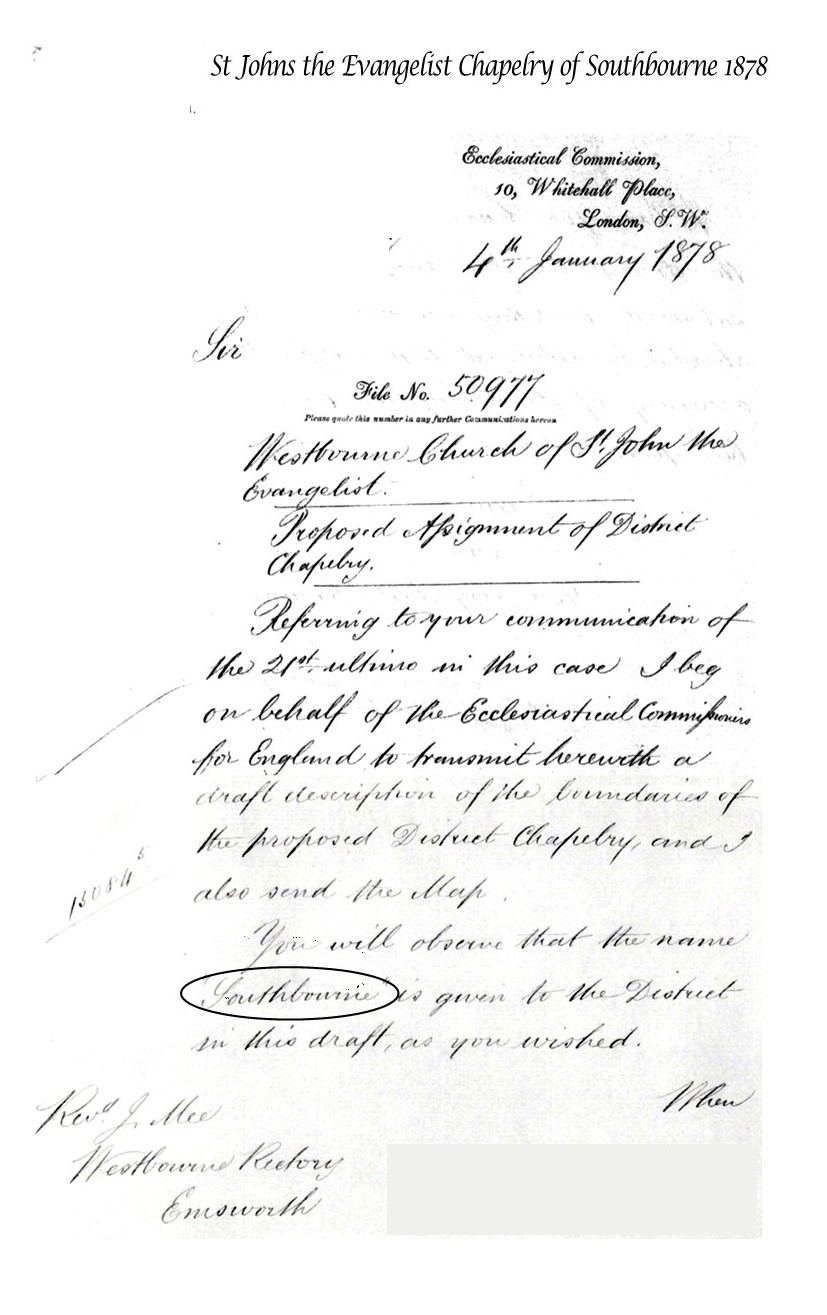
Vicars of Southbourne
1878 - 86 Rev. John F.E. Holloway
1886 - 92 Rev. Warneford S.T. Gompertz
1892 - 1914 Rev. W.J.B. Wonnacott
1914 - 27 Rev. A.N. Wynn
1927 - 30 Rev. J. Robertshaw
1930 - 54 Rev. William H. Carpenter
1954 - 62 Rev. Christopher Q Phillipson
1962 - 76 Rev. Harry Woodford
1976 - 96 Rev. Ronald W Poil
1996 - 2015 Rev. Clive R Jenkins
2016 - 2022 Rev. Matthew Luff
2023 - Rev. Tom Robson
Some Excerpts from the Vestry Book
In February 1879 a special meeting decided to apply for a faculty to place an organ in the South Transept. Whether this was granted and what made them change their minds we cannot discover but it would appear that the present organ chamber was added to the Church soon afterwards, for in April 1880 the sum of £6. 13s. 0d was collected for the “removal of the Organ”.
April 1885, the Vestry met on the 7th “when the accounts were audited and passed, there being a balance of 8s 3½ d in favour of the Churchwardens.” Shades of Micawber.
April 1887. A communication from the Rev. J.H. Mee, Rector of Westbourne, was read asking Southbourne to join with the mother church in celebrating Queen Victoria’s Jubilee and to raise the sum of £150 for that purpose. The Vestry replied as follows:
“Dear Mr. Mee,
Your letter relative to the intended Jubilee Celebrations was duly laid before our Annual Vestry Meeting and it was unanimously resolved to take no part in the said festivities. Could we raise such a sum as that named in your letter, we should at once devote it to the renovation of our Church roof.”
What had gone wrong? The roof was only eleven years old and this is the only reference we can find to it. Was it ever renovated or was this merely a diplomatic way of saying “no” to an unpopular proposal?
April 1888. The meeting assembled in the Vestry Room and then adjourned to the Board School Room (Now Southbourne Primary School) presumably because it needed more room, nine people being present (in those days the Church Vestry was only half its present size). One of the items on its agenda was “The Vestry Extension Undertaking” and in the following July, they had a special meeting to consider plans and to apply for a faculty. The vestry room we now have is the result. It is not very big and is totally inadequate as a choir vestry, but what can the original room have been like?
April 1888. Two other items on the agenda this year were Church Draughts and “the frequent smoking of the stoves”. The first problem is still with us and the second only disappeared a few years ago when we changed over to heating by electricity.
April 1889. It was decided to carry out the planting of the Churchyard in the following autumn. This is probably when they planted the Macrocarpas which eventually grew so big and overshadowed the Church and ruined the lawns and twenty years ago cost us so much money to remove.
April 1890. The accounts for this year showed an adverse balance of £2. 3s.11d., it being explained that this was due to certain additional expense, e.g. the purchase of an umbrella stand, the washing of the Choir Surplices, the purchase of two lamps, and the making of the Church Paths. The same meeting decided to use the church yard well, both for Church requirements and also in the event of fire. It is still there, in the corner in from of the War Memorial, but was covered with a stone slab a few years back.
The last item on the agenda for this year, we will repeat verbatim as it is still very topical:
“to memorialise the G.P.O. Authorities for the establishments of a Central Post Office at Westbourne and a sub-office mid-way between Nutbourne and Hermitage, for the latter to be known as “Southbourne (Sussex) Post Office,” with letters stamped accordingly, this being a measure due to a rising district of over 1,400 inhabitants, and one which would remedy the present delays and the annoyance of letters being mis-sent to Southbourne in Hampshire.”
This was 77 years ago and the population has quadrupled and the delays and annoyances still go on.
March 1891. This year again there was a small deficit and it was proposed to send a Subscription Book around the Parish to augment the collections. However, they decided to provide a small pump for the churchyard well, the Vicar contributing “the sum of 10s towards defraying the expense, that the matter might be forthwith taken in hand.”
Incidentally in the list of those present in 1889, 1890 and 1891 there appears the name of the Rev. T.W.Lawrence, M.A. Curate. His non-appearance in the list for 1892 suggests that he had moved on and never again has Southbourne enjoyed the luxury of the services of two resident clergy.
April 1892. The Vestry decided to re-varnish the pews and the church door, and to repaint the railings and Belfry shutters – the work to be carried out at “the churchwardens’ earliest convenience”. They also discussed the completion of the Organ Swell, but there was insufficient money so it was postponed.
April 1893. Presumably, money had been raised because this year they decided to obtain a faculty “for carrying out the alteration to the fabric necessitated by the addition to the organ. Unfortunately, there is no record of the cost.
July 1894. It was proposed: That the County Council be urged to provide for the division of the Parish of Westbourne (for civic purposes the Parish of Westbourne still includes Southbourne) into wards as suggested by the Resolution of the Vestry of Westbourne on a former occasion, which Resolution has not been rescinded.
The Ratepayers of Southbourne press for this on the following grounds:
1. Southbourne is more than a mile from Westbourne.
2. Many Ratepayers would have to walk from two to four miles to get to Westbourne Polling Station and distance would often debar them from recording their vote.
3. Southbourne has a population of 1107 out of 2409 in the whole parish and ought to be adequately represented on the Council.
4. This adequate representation is provided for in the Act and can only be secured by dividing the Parish into Wards as the Act provides and thereby giving to Southbourne a convenient polling station in the midst of the population in that division and by apportioning to it seven members.
5. It is the unanimous wish of the Ratepayers of Southbourne.
The two Wards were created but we do not know when and not at the time of writing 1967, it is proposed to separate the two Parishes for civic purposes.
April 1911. The scheme propounded by the Vicar for erecting a reredos and raising the altar by two steps as a memorial to the late King Edward VII and as a thanksgiving for the approaching coronation of King George V was unanimously approved.
The extra two steps to the altar may have been approved but then were very unpopular later and they were eventually removed in 1959.
April 1914. There is an entry in the accounts for the previous year “Legal expenses in the case of the Churchwardens of Southbourne v Portsea Island Co-operative Society ….. £4. 13s. 6d. We cannot trace any other reference to this business and we wonder what it was all about and who won.
April 1915. We note two items in the accounts, New Cassocks (probably 8) £1. 16s. 0d, Hassock 1s. 2d. We wonder why only one hassock and what a difference in price today.
July 1915. A Parochial Church Council was established many years before these were created by Act of Parliament. A constitution was drawn up and agreed and there is very little difference between this constitution and the one we use now, they even laid down the same procedure for the election of the councillors and the Annual Meeting.
Hermitage Mission
The minutes of the P.C.C. for Dec 16th 1915 record that Mr. Twine was asked to see the agents of “The Great Eastern”, Hermitage with the view of a loan of a room in which to hold a Service. It was granted and a Mission service was attended by 50 persons, mostly from that end of the parish. Another service was arranged for Feb. 10th, Mr. Michell Ellis had willingly lent the room and the question of making a permanent mission was discussed. The next reference is April 6th 1917 when the Vicar proposed that the congregation of the Hermitage Mission be allowed to nominate a member for election to the Council. Then on October 18th 1917, the Vicar submitted a copy of the Conveyance of the Hermitage Mission premises which was read and considered and the same meeting decided to start a Fund for the renovation of the Mission Buildings. We cannot trace how much was paid for the premises and how the money was raised. At the Easter Vestry held on April 4th 1918, the Vicar appointed Mr P. Ewens his Warden for the Hermitage Mission and it was decided to hand over the second Communion Set at the Church to the trustees of the Mission for use there. What happened to the repairs is not quite clear because the next reference is on Dec 19th 1920 when the Vicar reported that he had had a very good response to his appeal for the repairs to the Hermitage Mission Room, that it appears the Diocesan Board had only been postponed and might yet prove fruitful and that the total sum would be forthcoming if the parish duly supported the appeal. Again no sum is mentioned or any statement as to what the repairs were. However, they appear to have been done and at a later date they did manage to get £40 out of the Diocesan Board. From this time the Mission seems to have run its own affairs, occasionally the Parish Church made small donations but the Church accounts do not include Hermitage. The services were conducted by a lay reader, Mr. Penney, for many years until his departure from the Parish. In the later thirties, services were conducted by students from the Theological College in Chichester and then the Rectors of Thorney, the Rev Cruickshank, in July 1939 offered to assist and did so until he left to take charge of Funtington parish. Then the premises were damaged by enemy action and finally in 1941 they became unsafe and the Church furniture was removed into store, and after the war the premises were sold and the money held in trust by the Diocesan Board of Finance against the time when it will be possible to start a new Mission.
The Church Lighting
There is no mention of artificial lighting for the Church until a minute on July 11th 1919 which reads: “The lighting of the Church was discussed and it was reported that the Churchwardens as not willing to borrow lamps for another year. Proposed … that the Wardens be asked to make enquiries with regard to a lighting system for the Church, especially an Acetylene System”. There was no electricity in the Village then. The following month they accepted a quotation for a 20 lights plant and it was installed by a local man, the total cost being about £50. Exactly when electric light was installed we are unable to trace. Unfortunately in those days for a large item like this they had special funds which did not go through the ordinary Church Accounts, but it was before 1926 because there is mention of an electric light bill in the Accounts for that year. The Church was re-wired and flood lights at the side were added in 1957.
Church Heating
We presume that the original heating was by cylindrical coke stoves and one was certainly at the west end of the church roughly where the font now is, but we cannot trace the position of the other. Beyond an occasional mention of the stoves smoking all is silent till 1920, either the stoves were very efficient of our forefathers were more hardy than we are. A Church Heating fund was started in 1920 but did not make much progress. The following year they began getting quotations, which varied from £200 to £450. Eventually, it was done by an Emsworth man for just over £200 and it was completed by Christmas 1922. There was a boiler house outside below the West window and pipes fed hot water to radiators in various parts of the Church. Unfortunately, the boiler house was badly sited. It was sunk below the ground and easily flooded in wet weather. Before long there is an item to raise the boiler 8 inches, this may have improved matters but we remember seeing the stokehole flooded and the boiler out of action many times before it was finally superseded in 1952. It had been obvious for some time that a new system was needed and the P.C.C. investigated several methods before finally settling on the McClary Pipeless system. This consisted of a large furnace situated in the South corner of the north transept behind what is now the Vicar’s Vestry. This furnace was fired from outside and had an outer shell so that there was a considerable layer of air around it, this air escaping at the top of this shell and as hot air rises it was disseminated all over the church. After a few preliminary failures very good results were obtained and the church was much warmer. The cost of the stove and installation was about £350. But there were snags. The fire bars in the furnace quickly burnt out and needed replacement. This was easy until McClary went out of business when they had to be specially made. Further, it had to be lit on Saturday morning and needed a lot of attention till late that night, if the church was to be warm in the morning. This was difficult especially when there was no verger and it had to be done either by the Vicar or one of the Churchwardens. Inevitably there were times when the church was not adequately warm and once more the P.C.C. began to look around for something better. By now, heating by infrared electricity had been developed and this system, to a plan worked out for this church by the General Electric Company, was finally agreed at a cost of £240 and it was used for the first time at the induction of our present Vicar on 15th December 1962.
The Chancel
We have already recorded the raising of the altar by two steps and the addition of a reredos. The Chancel is small, it still is, yet originally it finished at the Chancel arch. The choir stalls were not as they are today and not only was the choir very cramped but the congregation complained of the difficulty in getting to the communion rail. First, they tried moving the choir into the nave. They altered the first two pews and the choir came there. But this was obviously not the solution and the Vicar drew up a scheme for improvement. This was referred to Mr. McDonald Gill who produced a comprehensive plan which included extending the chancel by some four feet and new choir stalls. The Council seems to have been in favour and a fund was opened but something went wrong. A meeting of those on the Electoral Roll was called, presided over by the Archdeacon and the scheme was turned down by a narrow margin. What the trouble was and how they got over it we have no idea, the minutes are silent, but the work was carried out the following year, 1925. The chancel was extended, the pulpit moved from the left to the right side and they built a wall along the front. This wall was cement-faced and presumably got dirty and then it was painted white and became an eyesore. For years the P.C.C. talked of getting rid of it but it survived until 1966 when in the comprehensive scheme of alteration and redecoration it was removed and replaced by the present low oak screen and the steps into the chancel were brought forward – this work being a gift from Capt.G.M.Rayne. At the same time Mrs G.Miles gave a new oak pulpit in memory of her mother, Mrs Gower, and this pulpit was placed in the original position on the north side of the church. This pulpit, the low chancel screen and the Lewis Goodin Memorial Screen were designed by Mr.C.Petch L.R.I.B.A.
The Screens
There are two, one on the left and the other on the right of the church. The one on the left encloses the Vicar’s Vestry and is a solid screen in oak design by Mr. F.Goodin and given by him and his brother, Mr L.B.Goodin in memory of their parents who worshipped in this church and both of whom were at some time members of the Parochial Church Council. It was dedicated at Harvest Festival Mattins on 26th September 1954. At the Easter Vestry 1953 Mr. L.B.Goodin was elected a Churchwarden. He had been a member of the P.C.C. since 1939 and was prominent in all Church work. In January 1960 his car skidded on an icy road, overturned and he was killed. It was a terrible shock to all his friends and the whole parish. In due course his colleagues and friends erected the oak screen which spans the south transept and separates the Lady Chapel from the Nave, to his memory.
The Lady Chapel
As originally planned both the north and south transepts were filled with pews facing inwards towards the nave. They were rarely if ever used and as we have already seen in the north transept is now the Vicar’s Vestry. On 21st August 1939, Richard E Twine died. He had been Churchwarden for forty years and intimately connected with the Church since its dedication. As a memorial to him, his widow gave the money to turn the south transept into a side chapel and ten years later on her death, her daughter and son-in-law gave the Altar rails and the Processional Cross in her memory. In the redecoration in 1966 very lovely blue curtains hanging from an oak pelmet were placed behind the altar and with the light pews it made a very delightful Lady Chapel, separated from the Nave by the Lewis Goodin Screen.
The Windows
The Church has three stained glass windows.
The East Windows bears the inscription in Latin: “To the greater glory of God and in pious memory of William Raleigh Baxter, M.D., L.D. died 1876, aged 63”. We know nothing more about this gentlemen except that his name appears in the original list of subscribers to the new church at Southbourne issue in 1875.
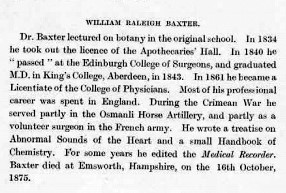
as living in Kings St. Emsworth


The West Window has this inscription: “In loving remembrance of Nathaniel Frary Miller of Mass.U.S. of America, Born 21Oct. 1821, died May 9 1869. Erected by his widow”. Again we know nothing more of this gentleman, but the name suggested that his widow may have lived a Fraryhurst, Prinsted.
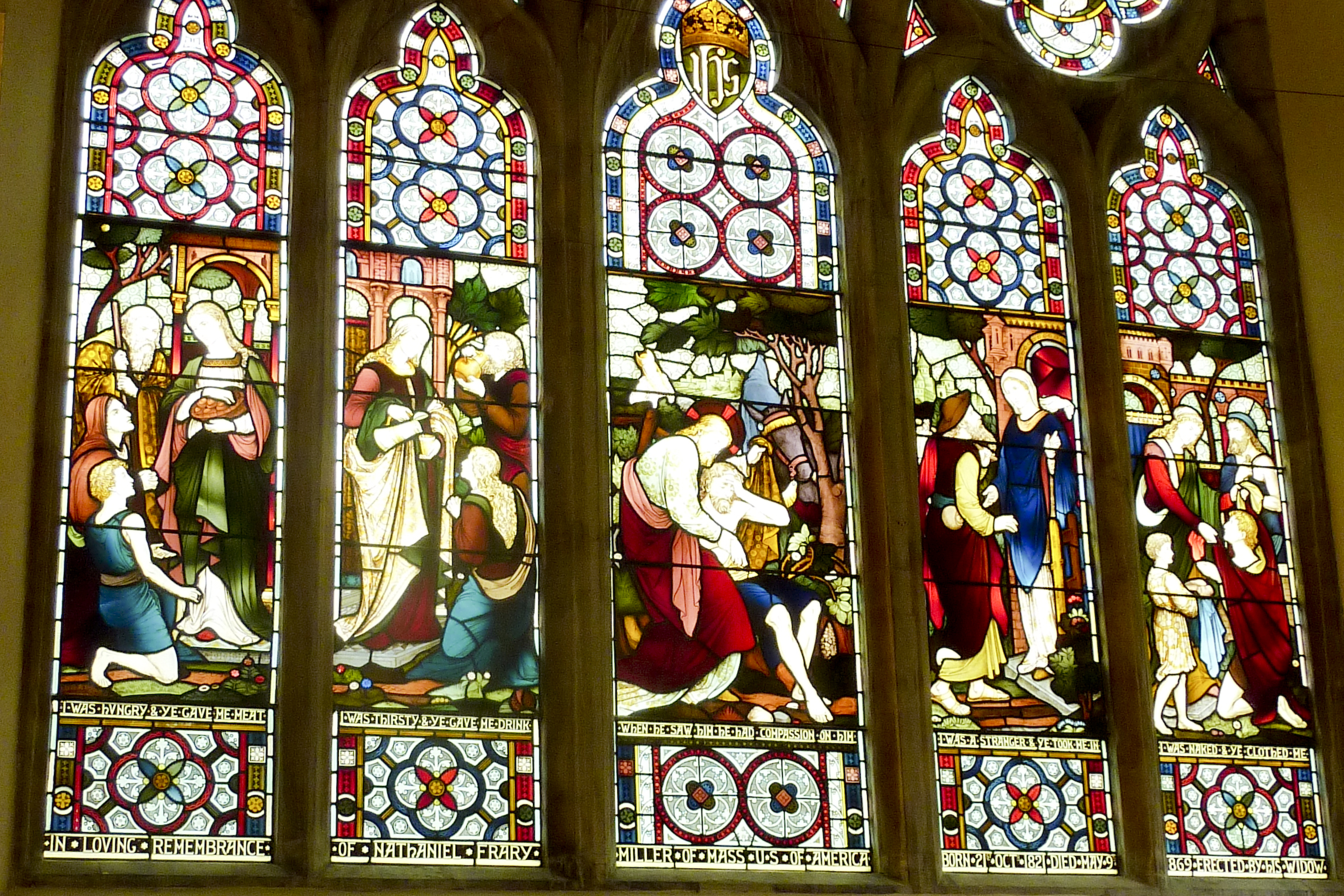
The third window is a really lovely one which being on the south side of the sanctuary, the congregation is probably not familiar with. It bears the inscription “In memory of Agnes Maud Pim, who with her little baby fell asleep, June 26 1892. With his angels.”
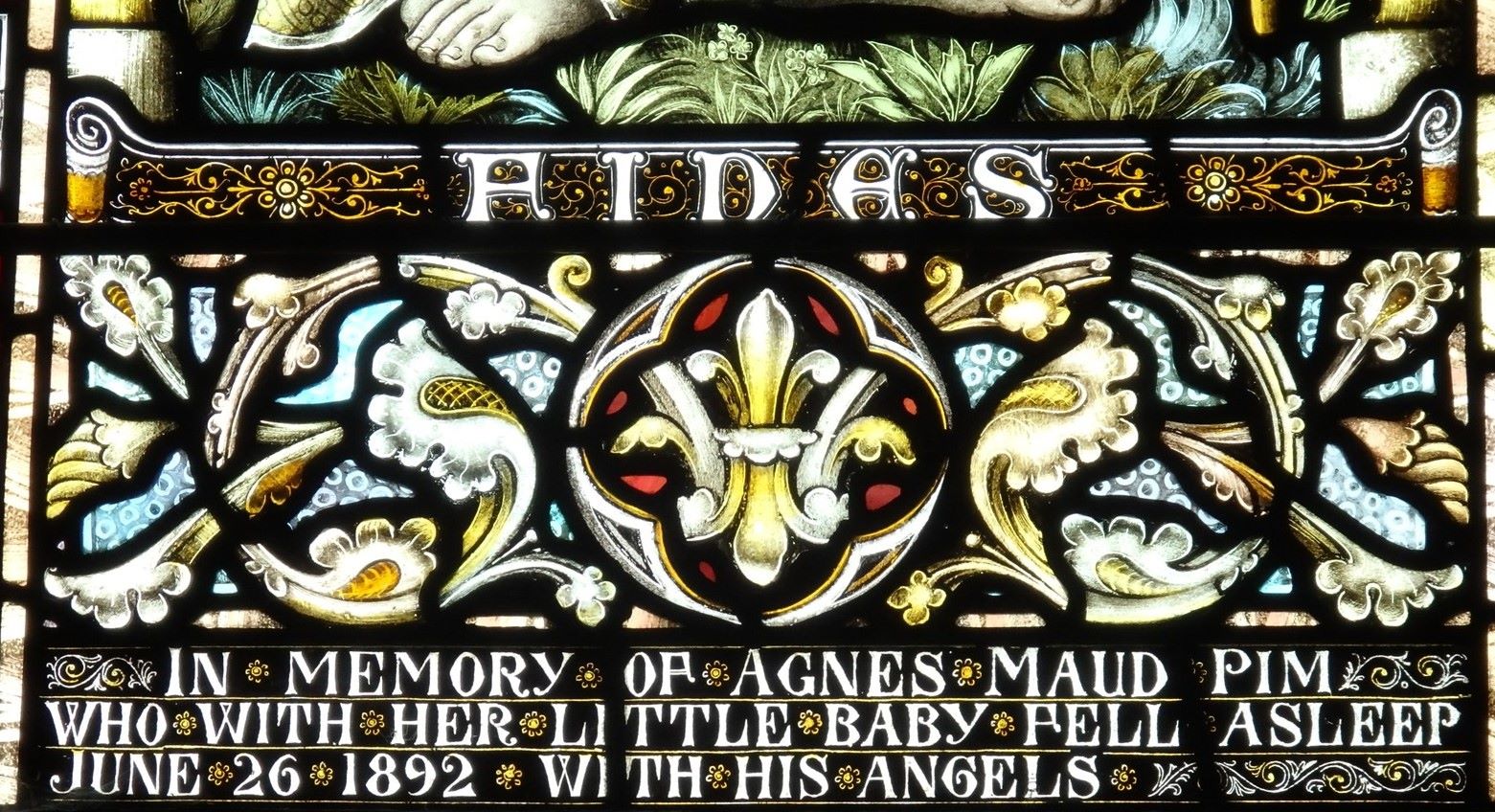
( in recent years research has been done regarding the windows, which is on this website)
The other windows in the Church had plain opaque glass set in diamond leaded panes, not very thrilling, but adequate. In the early hours of Monday June 22 1948 an Anti-aircraft shell fell and exploded about 2 feet from the N.W. Corner of the Church. All the windows on the north side were blown out and most of the others were damaged except for the stained glass windows - these by a miracle were untouched. There was also a little damage to the roof and the north wall of the church. Of course, at that time it was not possible to replace the leaded windows, so clear glass panes were put in at the expense of the War Damage Commission. They stayed like this until 1955 when Mr. L.B.Goodin took the matter up with the Commission again and after negotiation, they offered a cash payment of £107 towards restoring them. The Council decided to replace the windows in rectangular leaded panes with Fancy Heads using a proportion of antique Reamy glass. The work was done by Barton, Kinder and Alderson of Brighton for a total of £214. 3. 9d, so the parish had to find £107. The windows now are far nicer than they have ever been and are greatly admired.
The Organ
We have already mentioned the organ once or twice. There is very little information about it in the Minute Books but we know that it was rebuilt and two stops added just after the 1914-1918 war and it was again rebuilt about 1934 but what additions were made then have not been recorded. That was over thirty years ago and it cannot be long before it is completely overhauled and rebuilt again.
The Steeple
During his quinquennial inspection of the fabric of the Church in 1961 the architect employed steeplejacks to inspect the steeple. As a result it was found that the vane rod, being made of iron, was very rusty and was the cause of the capstone being cracked and there were also fractures lower down caused by rusting ironwork inside. A large amount of correspondence followed over the next eight or nine months and various estimates were given but finally, it was decided to replace the capstone with a new one, deal with the fractures, removing rusty ironwork from inside as much as possible, and not replace the weather-vane. The cost of doing this work was over £200.
The Roof
In the same inspection, the architect recommended that the Church should be re-roofed. The report is a lengthy one and full of technical terms and would be out of place in these notes. Suffice it to say that it had to be done. At the same time the interior of the roof was dealt with. Here pieces of plaster had fallen and others looked dangerous. So the inside was covered with 16x15x1/2” white-faced tongued and groove insulation board was fitted and painted. The total cost of this work was nearly £1,100.
In March 1920 the P.C.C. decided that a Cross with a garden surround should be placed in the churchyard and a marble tablet on the North wall of the Church as a memorial to those who fell in the 1914-1918 war. The Cross which stands about 13ft high on a platform with two steps was given by an anonymous donor and is situated at the corner of the Main Road and Stein Road. The marble tablet bearing the names of the fallen was placed on the north wall but had recently been moved to the west wall. The service of Dedication and Unveiling took place on Thursday January 6th 1921 and was conducted by the Archdeacon of Chichester. Presumably, the garden was laid out, because we have an appeal for volunteers to weed paths, cut grass edges and provide plants, but certainly since 1931 it has been grass only. Earlier in these notes we have mentioned the Macrocarpas which had been planted on the south side of the Church. In the course of years they had grown to a great height almost completely hiding the church from the road and ruining the grass and the hedge. At the end of 1947 the position had become desperate and the Council decided that the trees must come down and that they would erect nice gates and lay out the precincts with lawn and flower beds as a memorial to those who fell in the 1939-45 war. The trees were felled and a public appeal was made for funding to buy the gates. A new hedge was planted behind chestnut paling and lawns laid with two flower beds and a number of flowering cherry trees behind. Then the standing committee went to London and were fortunate in finding a pair of very nice wrought iron gates with side panels for £75. Stone pillars were erected and the gates hung and the dry wall edging to the lawns completed a very pleasing precinct. A tablet was fixed to one of the gate pillars recording the fact that this was a memorial to those who fell in 1939-45 and the unveiling took place at the Remembrance Service, Sunday, Nov. 11th 1951 by Admiral R.S.Phipps-Hornby C.M.G. Since then the flower beds and general appearance of the precincts of Southbourne Church have been greatly admired and caused much comment from the passers-by on this busy main road. The weeping willow tree that had been planted behind the War Memorial Cross in 1921 grew into a very lovely tree and made a wonderful background for the Cross. Unfortunately early in the 1960’s it was damaged in a storm and finally died in 1965. At the present, the dead stump remains and it is hoped that a clematis and honeysuckle will clothe it. This year the large flower bed has been planted with roses and it is hoped that there will be a good show in due course.
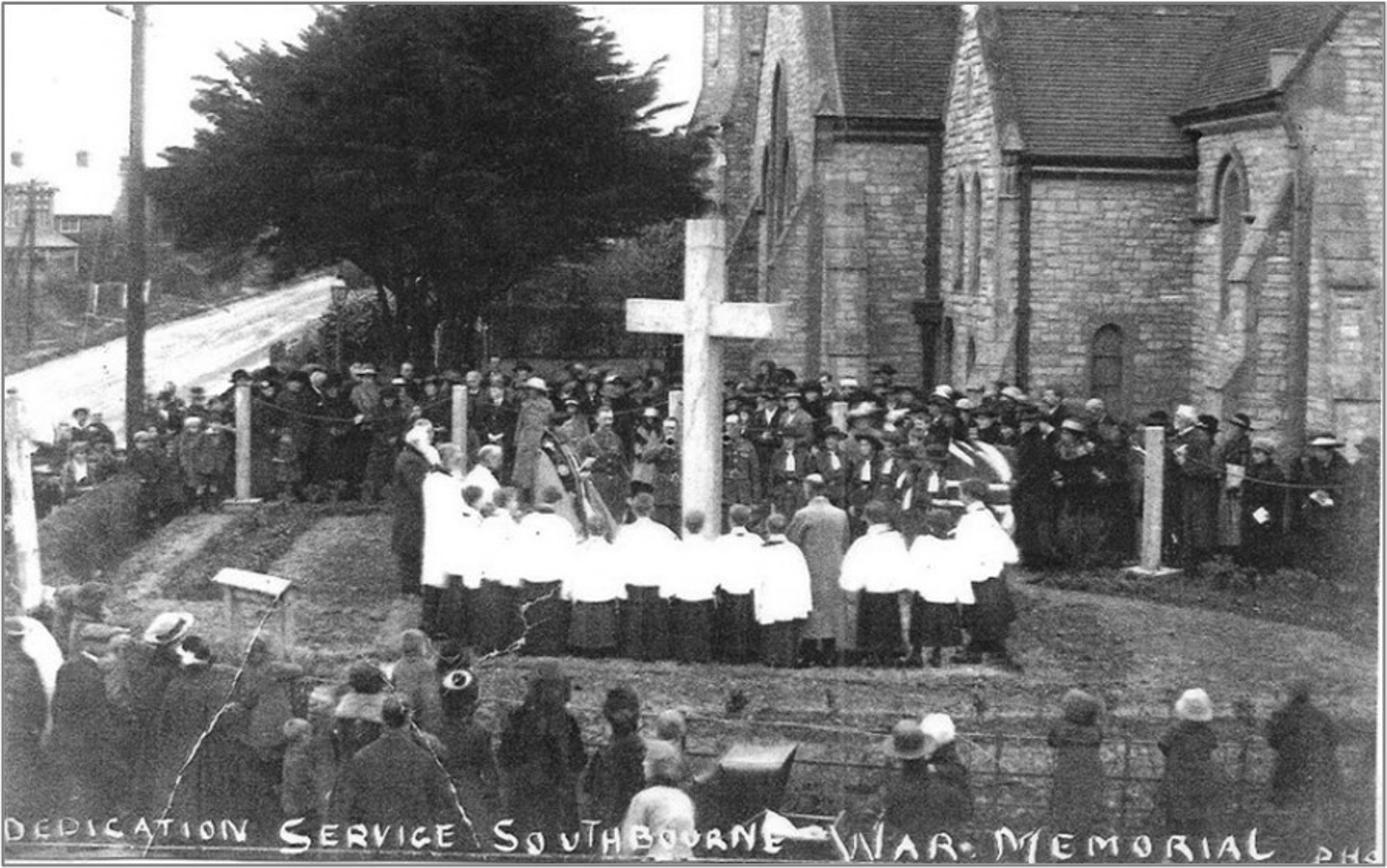
WW1 Memorial dedication Service 6th January 1921
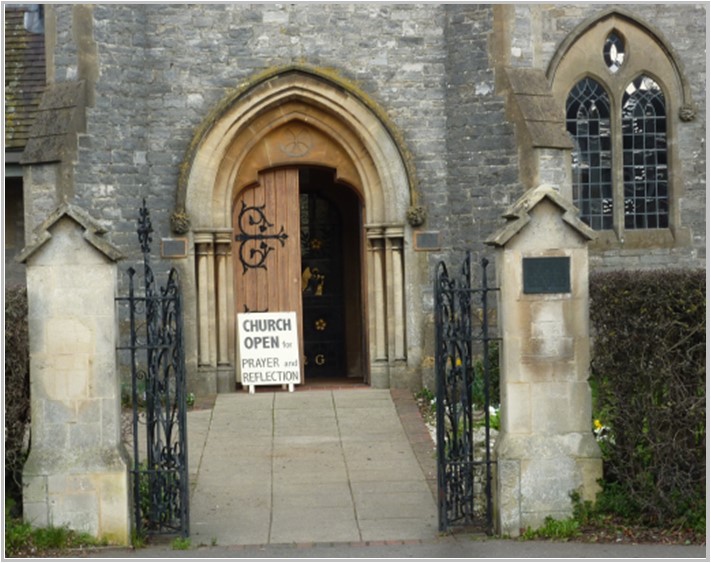
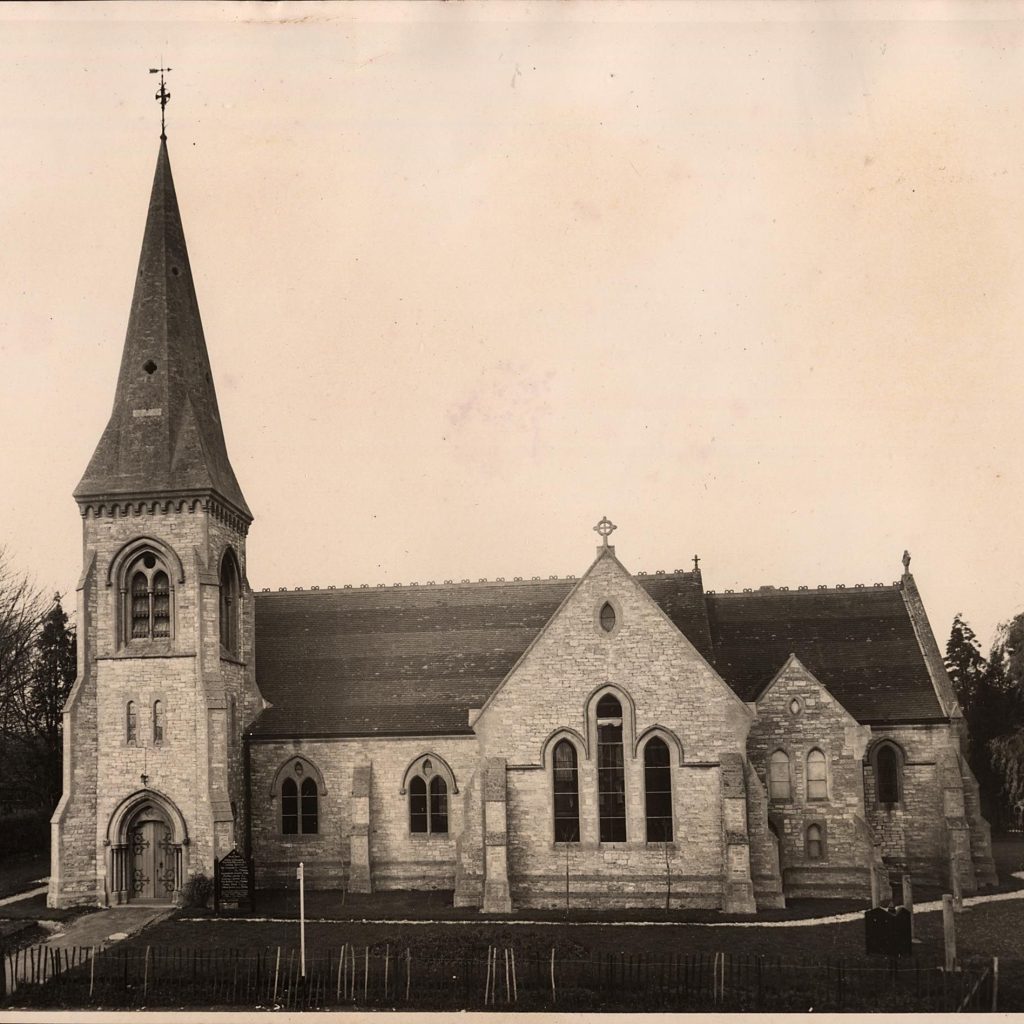
The Parish Boundaries
When the Parish of Southbourne was separated from Westbourne the northern boundary was the railway line and the eastern boundary was Cot Lane as far as Mill House. In the course of time these became ridiculous. There was a large development just north of the railway which was essentially part of this village and those living there considered this to be their Church. Also, the area around the Barleycorn was nearer to Chidham. There were a number of conferences before agreement was reached and in January 1958 the new boundaries, having been submitted to Her Majesty in Council and the ratification been published in the London Gazette became law. All those roads north of the railway up to and including South Lane to the point where it turns north are in Southbourne. From there the boundary goes due east till it reaches the Ham Brook which is the boundary from there, south to the railway, which is the boundary going east as far as Pottery Lane. The eastern boundary is a line drawn down the middle of Pottery Lane and then due south to the old parish boundary.
Re-decorating
Going through the minute books it is curious that not once can one find any reference to redecorating the walls of the Church, yet they must have been done. In the early days there is a minute that the Church was to have its annual spring-clean, presumably that was an extra clean and polish and removing such cob-webs as they could reach. In the last ten or fifteen years it was the constant ambition and intention of the Council that the Church should be completely re-decorated. But there were several alterations and additions to do first. Meanwhile, the walls were dirty and terribly dismal. But early in 1966 the new screen, pulpit etc., were completed, the font had been moved from the position just inside the door to a better site in the N.W. corner and the whole of the west end of the Nave had been tiled so re-decorating could start. And it was a complete re-decoration. Early in the 1930’s the pews, which up to then had been light coloured varnish, were made dark brown at a cost of £82. Now at a cost of £500 this dark brown stain was removed and the original wood colour restored, the chancel walls painted blue, the nave, pink etc. The final result has met with unqualified approval and the Church today looks better than it ever did. The ladies of the Parish are busy doing embroidered Hassock tops. More than 50 have been done so far and they make a very pleasant colourful addition.
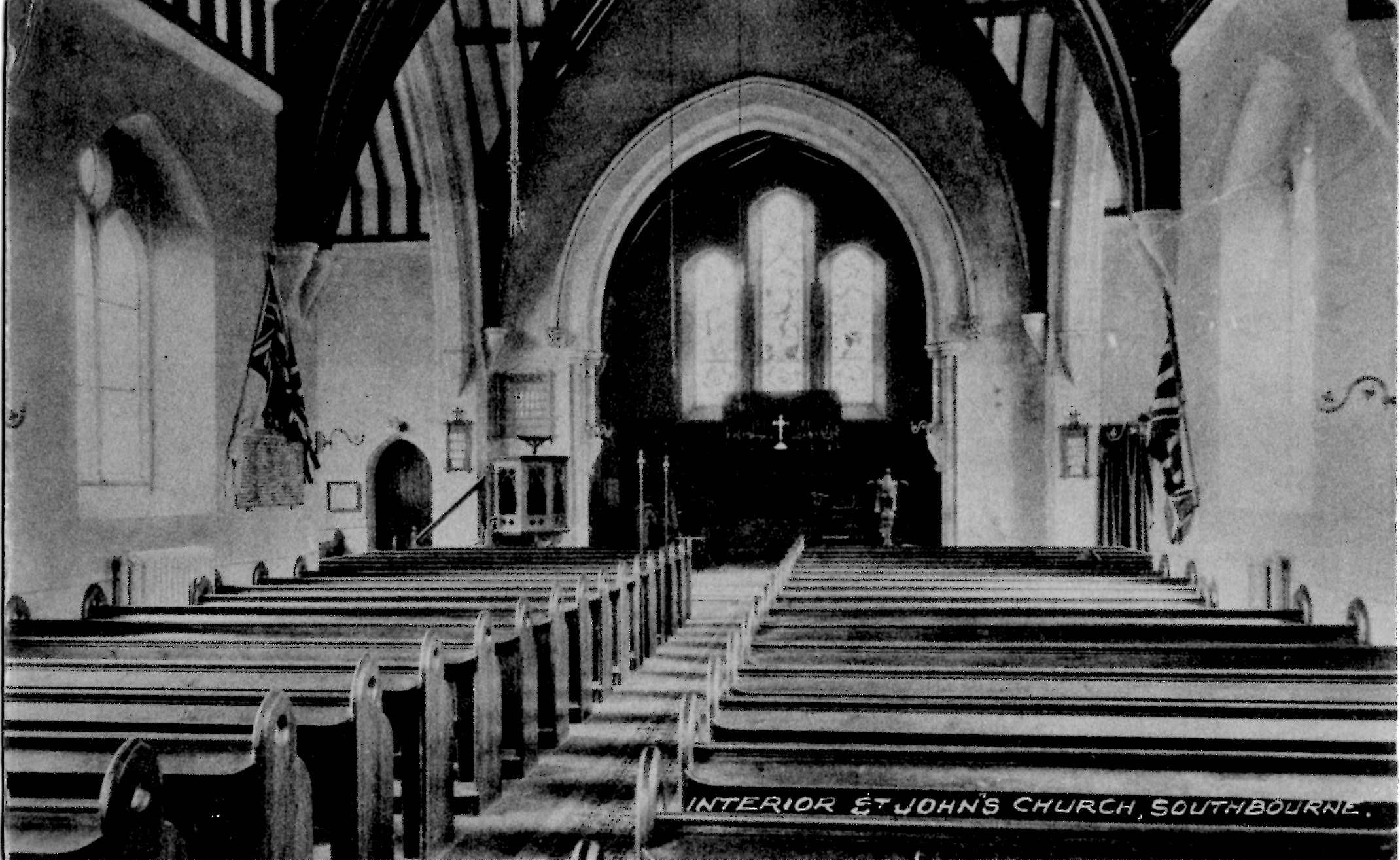
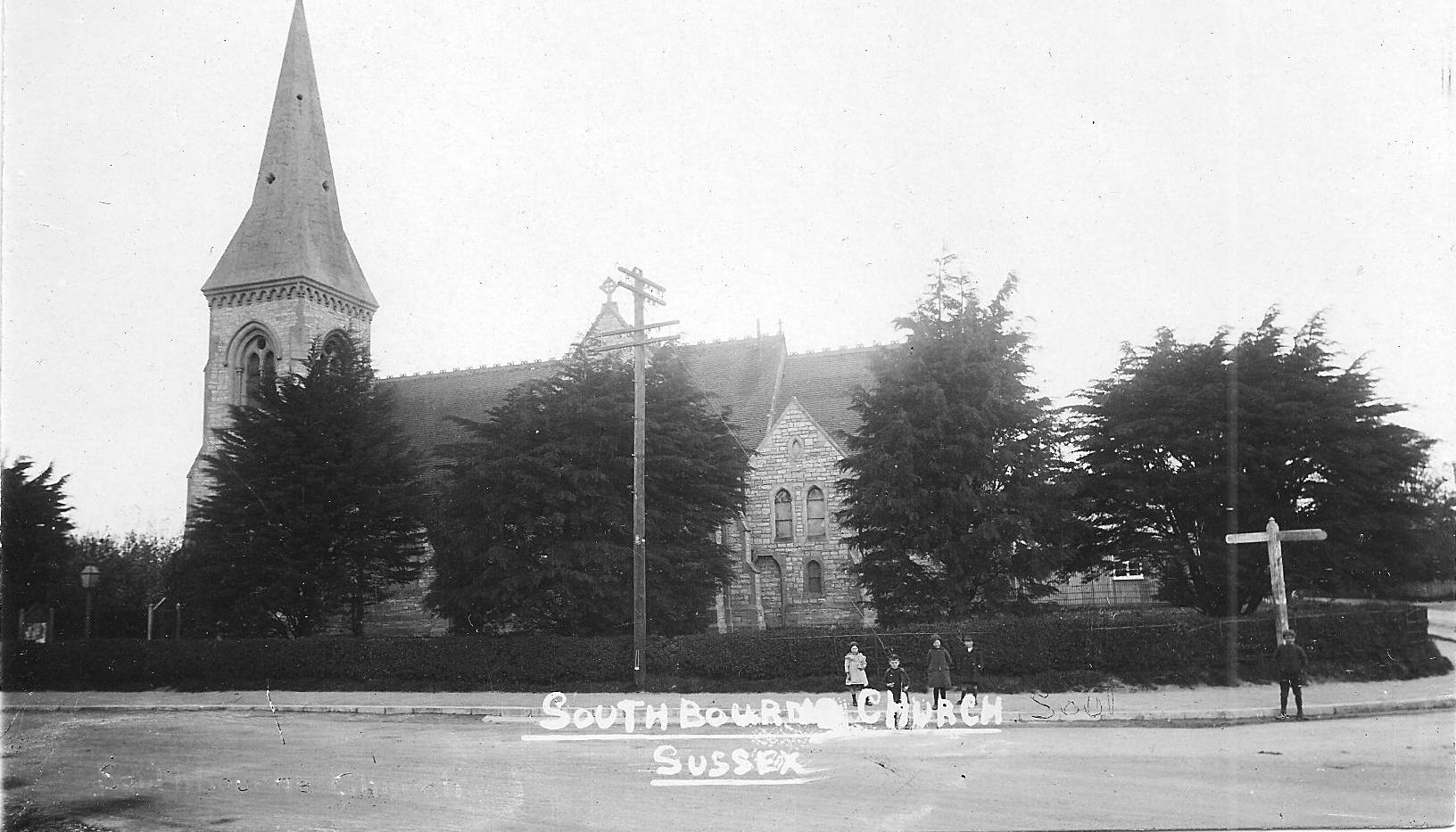
In Conclusion
I have compiled these notes on the history of and the changes that have taken place in our Church from the minute books of, first the Vestry and later the Parochial Church Council. Unfortunately, some secretaries seem to have thought that a list of the names of those present was all that was necessary and many events and changes we know have taken place are unrecorded. In some cases, it has been possible to tap other sources. The minute book for the years between 1935 and 1939 has disappeared. I came to live here in 1931 so can fill in part of this period from memory. I hope that in the years to come, somebody will carry on and keep these notes up-to-date. Minute books are useful but a more compact convenient history is needed. May I conclude by quoting something I wrote in the Parish Magazine for June 1959:
“Sitting one summer evening listening to the ear-splitting roar of motor-cycles and the perpetual hum of cars passing along the main road, it seemed impossible that only a few years ago – less that a life-time, this thoroughfare, not yet tarred, curbed or widened, only knew the lazy clip clop of the cart-horse or the pony pulling a smart trap. If one can visualise this, it is not so difficult to go further back, to see the Tudor peasant on his way to Chichester market, and the proud Norman on his way to his manors of Prinsted and Warblington or even to see the Roman Legions having landed at Portchester, making their way to the garrison town of Regnum. This old road has seen many changes over the centuries and doubtless will see many more.”
Our Church has stood proudly on this road for ninety years, a prominent land-mark, bearing witness. What will it see in the next ninety years?
H. W. Harris - February 1967
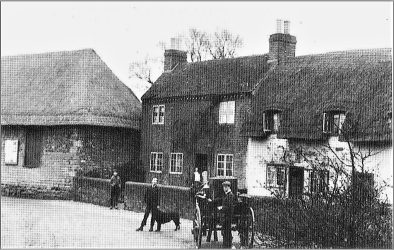
Prinsted Chapel + Rose Cottage
The building was a converted barn, very close to the pig sty. Rose Cottage on the right remains a residence.
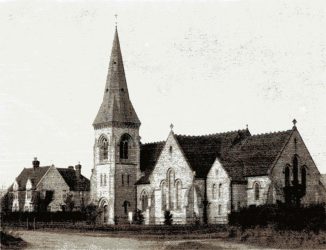
St-Johns-c-1900-vicarage-built-1882.2
St. John's Church c1900 with vicarage to the left built c1882.
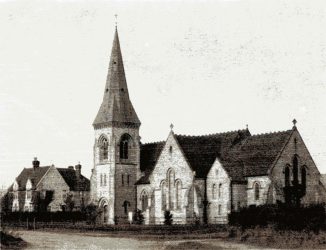
St-Johns-c-1900-vicarage-built-1882-001
St John's Church c1900 showing the vicarage, which was built c1882, on the left.
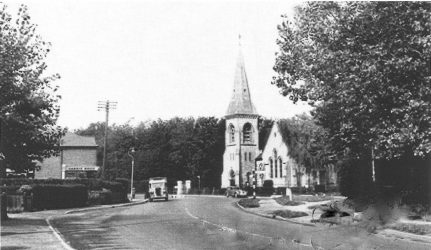
St-Johns-Church-corner
St Johns corner after 1951 when the Pillars and Gates were erected as the WW2 Memorial. The hedge and cherry trees were planted.
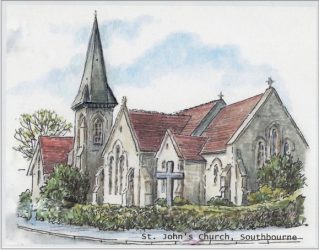
St Johns painted by Angela-Loader-
St. Johns Church watercolour painted by Angela Loader an Emsworth artist, for an illustrated map produced in 2018..
